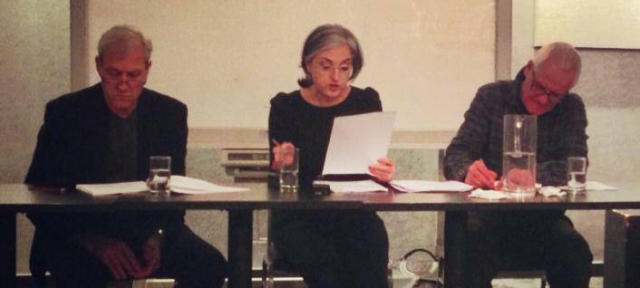 Venue: TAP Gallery (Darlinghurst NSW), Jul 17 – Aug 4, 2013
Venue: TAP Gallery (Darlinghurst NSW), Jul 17 – Aug 4, 2013
Playwright: Lee Blessing
Director: Duncan Maurice
Actors: Nick Dale, Laura Huxley, Coralie Bywater, Eli King
Theatre review
This is a story about terrorism and love. It goes into dark territory, dealing with loss and death, and the devastating failings of government. Design elements of the production are appropriately bleak and menacing. Both set and lighting work around the limitations of the space beautifully, creating a mood of foreboding that locates the story in a space of terror all post-9/11 audiences are familiar with. The theatre is totally darkened before the show begins, and members of the audience are given flash lights to navigate the way to their seats. These flash lights also allow an “interrogative process” to take place when we illuminate the actors already positioned on stage, both in states of distress, one with wrists bound and a bag covering his head. The implication of our complicity in the act of terrorism is immediately engaging, and spine-chilling.
Nick Dale’s performance as the captive, Michael, hits many right notes. He is on stage for virtually the entire duration, and the energy he is able to sustain in the portrayal of a disintegrating man gives the show its air of calamity and relentless tension. The actor’s physicality with his overgrown hair, unshaven face, and gaunt body is a manifestation of the level of commitment he brings to the role. Laura Huxley performs the depression and fear experienced by her character convincingly, and the slightness of her stature amplifies that mournful sadness. There is however, a lack of rage, or at least a more energetic edge that she could introduce, to create a more palpable sense of believability.
The play has beautiful moments when the lovers meet, figuratively or metaphysically. Perhaps sound could have been more effectively utilised to make those scenes more extraordinary, but it remains a great strength of the writing, that Lee Blessing is able to meld both worlds together. Two Rooms become one, and they become its other; it is the deconstruction of “us and them” that will always be a crucial element in the discussion of war, politics and (dare we imagine it?) peace.

 Venue: Bondi Pavilion Theatre (Bondi NSW), Jul 26-27
Venue: Bondi Pavilion Theatre (Bondi NSW), Jul 26-27 Venue: Bondi Pavilion Theatre (Bondi NSW), Jul 19 & 26
Venue: Bondi Pavilion Theatre (Bondi NSW), Jul 19 & 26 Venue: Bondi Pavilion Theatre (Bondi NSW), Jul 26-27
Venue: Bondi Pavilion Theatre (Bondi NSW), Jul 26-27
 Venue: Bondi Pavilion Theatre (Bondi NSW), Jul 17 & 24
Venue: Bondi Pavilion Theatre (Bondi NSW), Jul 17 & 24
 Venue: York Theatre, Seymour Centre (Sydney NSW), Jul 23, 26 & 27
Venue: York Theatre, Seymour Centre (Sydney NSW), Jul 23, 26 & 27